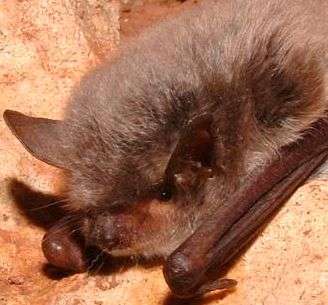Bats and rabies virus: More data on colonies at high risk

A new approach to rabies virus epidemiology in bats shows that the risk of infection is higher in large and multispecies colonies. The research, published on the journal PLOS ONE, has been led by Jordi Serra Cobo, professor from the Department of Animal Biology at the University of Barcelona and the Biodiversity Research Institute (IRBio).
Ecological factors are determinant
It is the first time that a research analyses ecological factors that might affect the infection dynamics of the rabies virus in bat colonies. Between 2001 and 2011, 2,393 blood samples were collected from 20 bats species and 25 localities in Catalonia, Aragon and Balearic Islands. The research is centred on the detection of European bat lyssavirus 1 (EBL1), one of the twelve different groups of the genus Lyssavirus related to rabies, an emergent zoonosis that affects mammals all over the world.
Jordi Serra Cobo, who also leads the Biology and Biotechnology Club of Alumni UB, explains that "EBLV-1 seroprevalence is strongly affected by colony size and species richness. Previous studies have analysed other aspects such as the seasonal variability. Ecological factors play a relevant role in seroprevalence variability, but they were to date unknown".
Different phylogeny, different response
Bats are a large group of mammals that appeared in our planet around 65 million years ago. They have colonized many natural habitats —except the poles—, and act as primary predators of vast numbers of insects in ecosystems. Besides, they are the mammals which present the widest variety of virus (rabies, SARS, Ebola, etc.). Moreover, they are able to neutralize virus and survive infections. "Chiropters, a quite ancient animal group, are major reservoirs for diverse infectious viral diseases", highlights Serra Cobo, director of CRIVIB. Unlike modern mammals, they have co-lived with virus for a long time and their immunological responses are more effective. According to the researcher, "this fact opens new research lines on organisms' immunological response and strategies to fight against infectious diseases".
Experts alert that all bat species do not response in the same way to viral infections. The research proves that immunological response to rabies virus varies among species. "Order Chiroptera has been widely diversified along its evolutionary history —affirms Serra Cobo— and their responses to ultrasound orientation mechanisms, immunological defence, etc. vary with different lineages".
There are more than 1,150 bat species all over the world and new specimens are described every year. However, the loss of natural habitats due to human activity (frequentation, urbanism, pollution, etc.) and climate changes pose a major thread to bats. "It is a process of environmental degradation which favours the formation of larger bat colonies, which have a higher probability of EBLV-1 infection", remarks Serra Cobo.
Time series: Long-term knowledge
Spain has been free of rabies in terrestrial mammals since 1977. Nevertheless, in some countries it continues to be a problem of public Health. To know risk factors involved in viral disease transmission is essential to improve preventive policies. The new article published on PLOS ONE completes the active surveillance of bat colonies implemented in Spain in 1992. The article, which confirms the scientific value of time series to know the dynamics of natural populations, will provide new tools to know more about viral infections epidemiology and natural resources management.
More information: Serra-Cobo, J. et al. (2013) Ecological Factors Associated with European Bat Lyssavirus Seroprevalence in Spanish Bats, PLoS ONE 8(5): e64467. DOI: 10.1371/journal.pone.0064467
Journal information: PLoS ONE
Provided by University of Barcelona
















